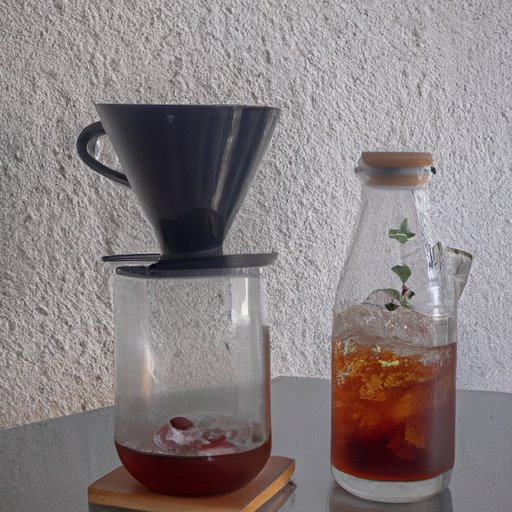
I. Introduction
Cold brew coffee has gained popularity in recent years due to its smooth taste and lower acidity levels compared to traditional coffee. Its origins can be traced back to the Dutch, who discovered that steeping coffee grounds overnight created a delicious, less bitter beverage. Making cold brew coffee at home is not only cost-effective, but it is also convenient, allowing you to have a refreshing coffee fix without stepping out of your home.
II. The Ultimate Guide to Making Cold Brew Coffee at Home
To make a delicious cold brew coffee, you need to get the right equipment, choose the right coffee beans, understand the ideal water-to-coffee ratio, determine the duration of the brewing process, and learn how to store the cold brew coffee correctly.
A. Required equipment for making cold brew coffee
You will need the following items: A jar or a French press, coffee beans, filtered water, and a cheesecloth or coffee filter.
B. Choosing the right beans
The quality of the coffee beans plays a significant role in the taste of your cold brew coffee. Opt for high-quality beans that suit your taste preferences. Light and medium roasts are popular choices due to their natural sweetness and fruity or nutty flavor profiles.
C. The ideal water-to-coffee ratio
The ideal ratio of water to coffee is 4:1. For example, if you use one cup of coffee, add four cups of water. You can adjust the ratio based on your preferences.
D. The duration of the brewing process
The standard brewing time is 12-24 hours, depending on your brew strength preferences. A longer brewing time creates a bolder taste, while a shorter brewing time produces a lighter taste. Remember to brew in the refrigerator for a chilled coffee fix.
E. Storing cold brew coffee
Store your cold brew coffee in an airtight container in the refrigerator for up to two weeks.
III. 5 Simple Steps to Crafting Delicious Cold Brew Coffee
A. Step-by-step instructions to create cold brew coffee
- Grind coffee beans coarsely.
- Add coffee grounds and water to jar or French press.
- Cover and store in the refrigerator for 12-24 hours (depending on the strength preference).
- Strain the coffee with a cheesecloth or coffee filter.
- Enjoy by adding sweeteners, milk, or creamer, and serve with ice cubes.
B. Tips for perfecting the craft
Experiment with different coffee beans, brewing time, and water to coffee ratios to create a personalized cold brew coffee. Clean equipment is essential, as stale coffee oils can make the coffee taste stale, so remember to wash equipment between uses. Pre-ground coffee can be used in place of whole beans for convenience, but it may not produce the same quality flavor profile.
IV. Master the Art of Cold Brew Coffee with These Easy Tips
A. Common mistakes when making cold brew coffee and how to avoid them
- Using stale coffee beans
- Using too much or too little coffee
- Not diluting the concentrated cold brew coffee
- Brewing at room temperature instead of in the refrigerator
B. Tips on how to customize the coffee to preference
Add flavors like vanilla extract, hazelnut syrup, cinnamon, or chocolate powder to create a customized flavor profile. Adjust sweetness levels with honey, sugar, or simple syrup. Dairy-free milk alternatives like almond, soy, or coconut milk can be used in place of milk or creamer.
C. Suggested recipes for flavoring
- Vanilla Cinnamon Cold Brew
- Caramel Cold Brew
- Chocolate Orange Cold Brew
V. How to Make Cold Brew Coffee: A Beginner’s Guide
A. Breakdown of the process in simple terms
Cold brew coffee involves steeping coffee grounds in cold water for an extended period. The result is a less acidic, smoother coffee concentrate that can be enjoyed hot or cold. The concentrate can be diluted with water or milk and be customized with different flavors and sweeteners.
B. Common terms used in cold brew coffee making
- Cold brew concentrate: A concentrated coffee mixture made by steeping coffee grounds in cold water.
- Bloom: The process of pouring hot water over coffee before brewing to release the gases trapped inside the beans.
- Toddy: A commercial cold brew coffee maker that uses a specific device for brewing.
C. Alternative methods for those without specific equipment
A French press or a jar can be used instead of a commercial cold brew coffee maker. A cheesecloth or coffee filter can be used to strain the concentrate.
VI. Get Your Caffeine Fix: DIY Cold Brew Coffee Made Easy
A. Additional benefits of making cold brew coffee
Cold brew coffee has less acidity than hot coffee, making it easy on the stomach. It is also rich in antioxidants, easy to make, and can be stored for up to two weeks.
B. Advantages of making it at home
- Cost-effective
- Customizable
- Freshly brewed
- Convenient
C. How to enjoy cold brew coffee
Cold brew coffee can be enjoyed hot or cold, diluted or concentrated, with added flavors or sweeteners. Its versatility makes it a popular choice among coffee enthusiasts.
VII. Conclusion
Now that you know the equipment, coffee beans, water-to-coffee ratio, brewing duration, and storage tips, making cold brew coffee at home has never been easier. Experiment with different flavors and ratios to find what suits your taste, and enjoy your delicious, cost-effective caffeine fix.
A. Recap of the advantages of making cold brew coffee at home
Cost-effective, customizable, freshly brewed, convenient, and versatile.
B. Encouragement for trying out the process
Don’t hesitate to try making cold brew coffee at home. It’s simple, cost-effective, and easy to customize, ensuring a personalized coffee fix to your taste preferences.
C. Final thoughts on the process
Cold brew coffee is gaining popularity among coffee drinkers due to its less acidic, smoother taste profile. Making it at home is cost-effective, convenient, and customizable, providing a fresh caffeine fix in the comfort of your own home.




